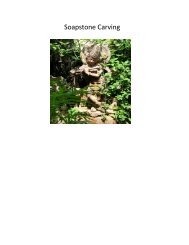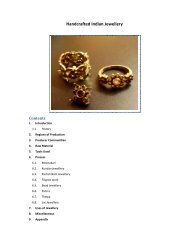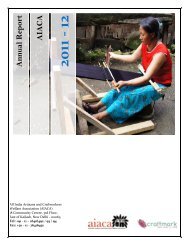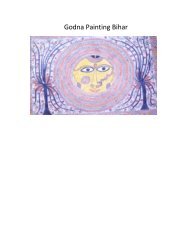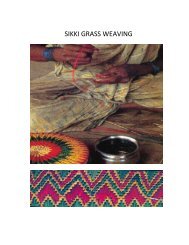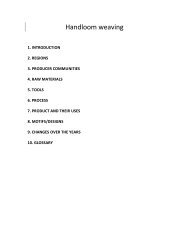Block Printing - All India Artisans and Craftworkers Welfare Association
Block Printing - All India Artisans and Craftworkers Welfare Association
Block Printing - All India Artisans and Craftworkers Welfare Association
Create successful ePaper yourself
Turn your PDF publications into a flip-book with our unique Google optimized e-Paper software.
now may have multiple block printers working simultaneously on imprinting the fabric<br />
depending upon the intricacies of the design.<br />
The block printer pushes along small wooden trolleys with racks that have castor wheels<br />
fastened to their legs to facilitate free movement as he works. On the upper most shelf<br />
trays of dye are placed. On the lower shelves printing blocks are kept ready.<br />
These blocks are then dipped in dye <strong>and</strong> imprinted on to the fabric by a skilled blockprinter.<br />
The printing starts form left to right. The color is evened out in the tray with a<br />
wedge of wood <strong>and</strong> the block dipped into the outline color (usually black or a dark<br />
color). When the block is applied to the fabric, it is slammed hard with the fist on the<br />
back of the h<strong>and</strong>le so that a good impression may register. A point on the block serves<br />
as a guide for the repeat impression, so that the whole effect is continuous <strong>and</strong> not<br />
disjoined. The outline printer usually is more experienced because he is the one who<br />
leads the process.<br />
[Photograph 7: Cloth printing by the master block printer]<br />
If it is a multiple color design the second printer dips his block in color again using the<br />
point or guide for a perfect registration to fill in the color. The third color if existent<br />
follows likewise. Skill is necessary for good printing since the colors need to dovetail into<br />
the design to make it a composite whole. A single color design can be executed faster, a<br />
double color takes more time <strong>and</strong> multiple color design would mean additional labor<br />
<strong>and</strong> more color consumption.<br />
Different dyes are used for silk <strong>and</strong> cotton. Rapid fast dyes, indigo sol <strong>and</strong> pigment dyes<br />
are cotton dyes. <strong>Printing</strong> with rapid dyes is a little more complicated as the dyes once<br />
mixed for printing have to be used the same day. St<strong>and</strong>ard colors are black, red, orange,<br />
brown <strong>and</strong> mustard. Color variation is little difficult <strong>and</strong> while printing it is not possible<br />
to gauge the quality or depth of color.<br />
5




